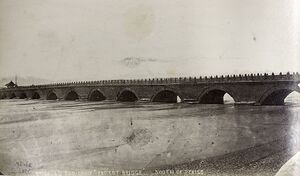Marco Polo incident
 | |
| Date | 7 July 1937 - 9 July 1937 |
|---|---|
| Location | Beijing, China |
| Perpetrators | China, Japan |
| Blamed on | Soldiers |
| Deaths | 750 |
| Description | The official start of the Asian theatre of World War 2, and chronologically, World War 2 as a whole. |
The Marco Polo Bridge Incident or known as the Lugou Bridge Incident (traditional Chinese: 盧溝橋事變; simplified Chinese: 卢沟桥事变; pinyin: Lúgōuqiáo Shìbiàn) or the July 7 Incident (simplified Chinese: 七七事变; traditional Chinese: 七七事變; pinyin: Qīqī Shìbiàn, Japanese: 盧溝橋事件 Rokōkyō Jiken), was an incident that is regarded to have started the Asian part of World War 2. Chinese soldiers fired on the occupying Japanese soldiers during a dispute around a missing solider, controversy is still ongoing on how much of an incident that was.[1]
Background
Japan and China were already in border disputes since the Invasion of Manchuria in 1931 and subsequent creation of a puppet state, Manchukuo, with Puyi, the last monarch of the Qing Dynasty, as its absolute leader. The Kuomintang government of China refused recognizing Manchukuo, which didn't work as Japan invaded other provinces just to make up for it.
By the start of 1937 all the areas north, east and west of Beijing were controlled by Japan. The Marco Polo Bridge, located near the town of Wanping (宛平鎮) was an important junction in the Pinghan Railway to Wuhan, and was occupied by the the Japanese military that had repeatedly demanded the withdrawal of all Chinese forces.
When Japanese troops started performing "training exercises" without informing the Chinese, Japanese forces got shot at, and fired back. Things escalated when a Japanese solider failed to return from one so-called training exercise, causing his commander to ask Chinese forces surrounding Beijing to search the city for the solider. When the request was ignored and the Chinese went searching anyway, in the chaos of negotiating who and where to look and with which witnesses, the Japanese and Chinese began firing, starting the Sino-Japanese war to enter its second episode, effectively starting WW2.[2]
Controversy
Whether the incident was planned like the earlier false flag Mukden Incident, is still a point of discussion. Opinions vary by scholars pointing out Japan already was busy with Stalin and the Soviet Union surrounding the island of Sakhalin, while others suggested the Chinese Communist party provoked the incident to wear the Japanese army out.[3][4]
The Official Culprit
| Name | Description |
|---|---|
| Soldier | Military personnel are at the very center of deep state activities. |
References
- ↑ https://www.vaildaily.com/news/vail-daily-letter-beware-of-false-flags/
- ↑ https://en.wikipedia.org/wiki/Marco_Polo_Bridge_Incident#Background
- ↑ https://books.google.com/books?id=YWLhAQAAQBAJ&pg=PA140
- ↑ https://www.google.com/url?sa=t&rct=j&q=&esrc=s&source=web&cd=&cad=rja&uact=8&ved=2ahUKEwiMo5uX36X9AhXo8rsIHduqAdcQFnoECAsQAQ&url=https%3A%2F%2Fwww.jstor.org%2Fstable%2F2050187&usg=AOvVaw2ZvAdlW88QZUc23HuOvf1H